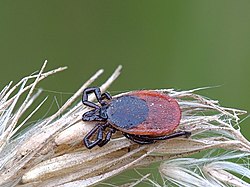











There are approximately 1,107 species of arachnid native to Ireland. [11] This page lists them, but is not up to date for all taxa.
Contents
- Subclass Dromopoda
- Order Opiliones (harvestmen / daddy-long-legs)
- Order Pseudoscorpionida (false scorpions)
- Subclass Acari (ticks and mites)
- Order Ixodida (ticks)
- Order Prostigmata (sucking true mites)
- Order Sarcoptiformes (Clade)
- Suborder Oribatida (moss mites / beetle mites)
- Suborder Brachypylina
- Suborder Astigmatina
- Order Trombidiformes
- Order Araneae (spiders)
- Family Agelenidae (funnel-web spiders)
- Family Amaurobiidae (tangled nest spiders)
- Family Anyphaenidae
- Family Araneidae (typical orb-weavers)
- Family Atypidae (purseweb spiders)
- Family Cheiracanthiidae
- Family Clubionidae (sac spiders)
- Family Cybaeidae
- Family Dictynidae
- Family Dysderidae (woodlouse hunters)
- Family Gnaphosidae (flat-bellied ground spiders)
- Family Hahniidae (dwarf sheet spiders)
- Family Linyphiidae (sheet weavers)
- Family Liocranidae (Liocranid sac spiders)
- Family Lycosidae (wolf spiders)
- Family Mimetidae (pirate spiders)
- Family Miturgidae
- Family Nesticidae (scaffold web spiders)
- Family Oonopidae (goblin spiders)
- Family Philodromidae (running crab spiders)
- Family Pholcidae (cellar spiders)
- Family Pisauridae (nursery web spiders)
- Family Salticidae (jumping spiders)
- Family Segestriidae (tube-dwelling spiders)
- Family Scytodidae
- Family Sparassidae
- Family Tetragnathidae (long-jawed orb weavers)
- Family Theridiidae (tangle-web spiders)
- Family Theridiosomatidae (ray spiders)
- Family Thomisidae (crab spiders)
- Family Uloboridae (hackled orb weavers)
- See also
- References
- Further information
- Identification
- External links
Arachnids are eight-legged chelicerate arthropods with pedipalps and bodies divided into two tagmata.
The most best known and familiar group in Ireland is the spiders, and there are also several species of harvestman (daddy-long-legs), ticks, mites and pseudoscorpions. Arachnid groups absent from Ireland include true scorpions, whip scorpions, solifuges, cave spiders, microwhip scorpions, hooded tick spiders and tarantulas.